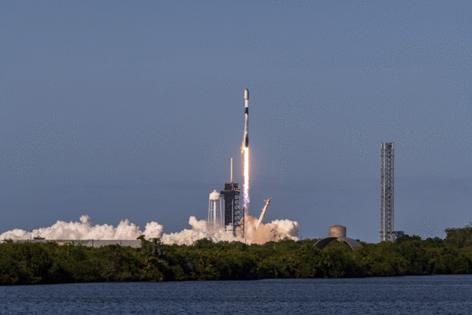FAA initiates environmental impact study for SpaceX Starship launches from KSC
Published in News & Features
SpaceX’s plans to build a Starship launch complex at Kennedy Space Center are moving closer to reality even as it potentially takes over a launch site from neighboring Cape Canaveral Space Force Station.
The Federal Aviation Administration said it was beginning an Environmental Impact Statement for Starship launches from KSC’s Launch Complex 39-A. SpaceX had already built the beginning of a Starship launch tower adjacent to its existing pad that supports Falcon 9 and Falcon Heavy launches.
Noticeable work on that new launch tower stopped in late 2022 as SpaceX shifted focus to develop its Starship and Super Heavy rocket from its Texas test launch site where it has managed three flights with varying degrees of success. The powerful rocket produces more than 16 million pounds of thrust at liftoff, nearly double that of NASA’s Space Launch System rocket for its Artemis program.
The most recent launch in March saw the Starship upper stage finally achieve orbit before it burned up on reentry over the Indian Ocean while the Super Heavy booster crashed into the Gulf of Mexico. The previous two launch attempts both ended explosively. SpaceX is currently preparing for its fourth test flight.
NASA, which leases LC 39-A to SpaceX, had in 2019 completed a less rigorous Environmental Assessment under the National Environmental Policy Act for Starship, but it was never submitted to the FAA for a launch license. Changes in the rocket design since and SpaceX’s intended launch plans prompted NASA to call for a more stringent EIS, a process that could take around 18 months to complete.
“The SpaceX proposal includes constructing the necessary infrastructure to support up to 44 launches per year from Launch Complex 39-A with Super Heavy booster and Starship vehicle recovery landings at LC 39-A or on a droneship, or expending them in the ocean,” reads a statement from the FAA.
The call for 44 launches builds on 2019’s plans that called for up to 24. That plan also envisioned landings at Canaveral’s Landing Zone 1 similar to how Falcon 9 boosters return to land. The new plan envisions Super Heavy boosters returning back to the launch site at KSC.
For now, the fully stacked rocket takes off from a 469-foot-tall launch integration tower at the Texas site, which SpaceX CEO Elon Musk refers to as “Mechazilla.” It’s designed to one day capture the Super Heavy booster on its return with the aid of two pivoting metal arms called the “chopsticks,” but that has yet to happen.
The FAA published its notice to conduct the EIS on Friday on the federal register.
Up next are two in-person public meetings on June 12 from 2-4 p.m. and 6-8 p.m. at the Radisson Cape Canaveral at 8701 Astronaut Blvd. in Cape Canaveral and June 13 from 6-8 p.m. at the Kennedy Space Center Visitor Complex on Space Commerce Way in Merritt Island. There will also be one virtual meeting on June 17 from 6-8 p.m. accessible from the FAA’s SpaceX Starship-Super Heavy at Kennedy Space Center’s project webpage.
...continued
©2024 Orlando Sentinel. Visit at orlandosentinel.com. Distributed by Tribune Content Agency, LLC.







Comments